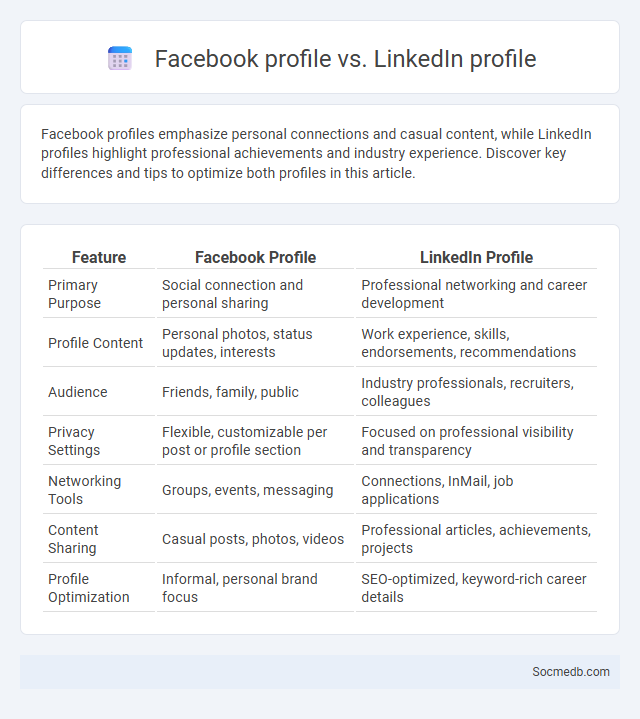
Photo illustration: Facebook Profile vs LinkedIn Profile
Facebook profiles emphasize personal connections and casual content, while LinkedIn profiles highlight professional achievements and industry experience. Discover key differences and tips to optimize both profiles in this article.
Table of Comparison
| Feature | Facebook Profile | LinkedIn Profile |
|---|---|---|
| Primary Purpose | Social connection and personal sharing | Professional networking and career development |
| Profile Content | Personal photos, status updates, interests | Work experience, skills, endorsements, recommendations |
| Audience | Friends, family, public | Industry professionals, recruiters, colleagues |
| Privacy Settings | Flexible, customizable per post or profile section | Focused on professional visibility and transparency |
| Networking Tools | Groups, events, messaging | Connections, InMail, job applications |
| Content Sharing | Casual posts, photos, videos | Professional articles, achievements, projects |
| Profile Optimization | Informal, personal brand focus | SEO-optimized, keyword-rich career details |
Introduction: Understanding Different Online Profiles
Different online profiles on social media platforms reflect diverse user identities, interests, and interaction styles, shaping your digital presence uniquely. Profiles vary from personal, professional, to anonymous or brand-focused, each serving distinct purposes and audiences. Understanding these variations helps tailor your social media strategy for optimal engagement and privacy management.
Purpose and Audience: Facebook vs LinkedIn vs Generic Profiles
Facebook primarily targets personal connections and social interactions, allowing you to share updates, photos, and engage with friends and family in a casual environment. LinkedIn focuses on professional networking, job opportunities, and industry-specific content, making it ideal for career growth and business relationships. Generic profiles lack the specialized features of these platforms, providing a broad but less effective way to connect without tailoring to specific audience purposes.
Profile Structure and Key Features
Your social media profile structure plays a pivotal role in establishing your online identity, with key features such as a clear profile picture, concise bio, and consistent username enhancing recognition and trust. Interactive elements like story highlights, pinned posts, and verification badges significantly boost engagement and credibility. Optimizing these components ensures your profile attracts the right audience and effectively communicates your personal or brand message.
Privacy Settings and Control Options
Social media platforms offer comprehensive privacy settings that allow users to control who can view their content, send messages, and access personal information. Features such as customizable audience selectors, two-factor authentication, and activity log reviews empower users to enhance their account security and manage visibility. Regular updates to privacy controls ensure compliance with evolving data protection laws like GDPR and CCPA, safeguarding user data against unauthorized access.
Content Sharing and Engagement Differences
Social media platforms exhibit distinct content sharing and engagement patterns influenced by their design and audience demographics. Visual-centric platforms like Instagram emphasize image and video sharing, resulting in higher engagement through likes and comments, while Twitter focuses on quick text updates and real-time interaction, driving rapid content dissemination and discussions. LinkedIn prioritizes professional content and networking, encouraging sharing of industry insights and fostering engagement through thoughtful comments and shares.
Professional vs Personal Branding
Professional branding on social media emphasizes showcasing expertise, industry experience, and career accomplishments to attract potential employers or business opportunities. Personal branding highlights unique personality traits, hobbies, and daily life moments to build genuine connections and engage a broader audience. Balancing both approaches strategically enhances online reputation and expands influence across professional networks and personal communities.
Networking Opportunities: Social vs Career-Focused
Social media platforms like Facebook and Instagram excel in fostering personal connections and broad networking opportunities through informal interactions and shared interests. LinkedIn, a career-focused platform, prioritizes professional networking by enabling users to showcase expertise, connect with industry leaders, and access job opportunities. The choice between social and career-focused platforms significantly impacts the effectiveness of networking efforts based on users' goals for relationship-building or career advancement.
SEO and Discoverability on Each Platform
Optimizing social media content for SEO enhances discoverability by incorporating relevant keywords, hashtags, and high-quality backlinks specific to each platform's algorithm. Tailoring metadata, such as video descriptions on YouTube or alt text on Instagram, boosts search rankings and user engagement. Consistent use of platform-specific SEO strategies, including optimizing profiles and leveraging trending topics, drives organic traffic and improves content visibility across audiences.
Visual Presentation: Photos, Videos, and Layouts
High-quality photos and engaging videos significantly enhance social media visibility by capturing user attention and increasing interaction rates. Well-organized layouts improve user experience and encourage longer session durations, directly boosting platform algorithms that prioritize visually appealing content. Consistent use of branded visual elements strengthens identity recognition across platforms like Instagram, TikTok, and Facebook, driving higher engagement and follower growth.
Choosing the Right Profile for Your Goals
Selecting the appropriate social media profile aligns your online presence with your specific goals, whether personal branding, business marketing, or community engagement. Tailoring profile elements like username, bio, and visual identity ensures clear communication of your objectives to your target audience. Understanding platform demographics and functionalities maximizes effectiveness in reaching desired outcomes.
 socmedb.com
socmedb.com